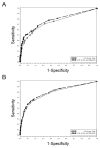Infection after intracerebral hemorrhage: risk factors and association with outcomes in the ethnic/racial variations of intracerebral hemorrhage study
- PMID: 25316275
- PMCID: PMC4245453
- DOI: 10.1161/STROKEAHA.114.006435
Infection after intracerebral hemorrhage: risk factors and association with outcomes in the ethnic/racial variations of intracerebral hemorrhage study
Abstract
Background and purpose: Risk factors for infections after intracerebral hemorrhage (ICH) and their association with outcomes are unknown. We hypothesized there are predictors of poststroke infection and infections drive worse outcomes.
Methods: We determined prevalence of infections in a multicenter, triethnic study of ICH. We performed univariate and multivariate analyses to determine the association of infection with admission characteristics and hospital complications. We performed logistic regression on association of infection with outcomes after controlling for known determinants of prognosis after ICH (volume, age, infratentorial location, intraventricular hemorrhage, and Glasgow Coma Scale).
Results: Among 800 patients, infections occurred in 245 (31%). Admission characteristics associated with infection in multivariable models were ICH volume (odds ratio [OR], 1.02/mL; 95% confidence interval [CI], 1.01-1.03), lower Glasgow Coma Scale (OR, 0.91 per point; 95% CI, 0.87-0.95), deep location (reference lobar: OR, 1.90; 95% CI, 1.28-2.88), and black race (reference white: OR, 1.53; 95% CI, 1.01-2.32). In a logistic regression of admission and hospital factors, infections were associated with intubation (OR, 3.1; 95% CI, 2.1-4.5), dysphagia (with percutaneous endoscopic gastrostomy: OR, 3.19; 95% CI, 2.03-5.05 and without percutaneous endoscopic gastrostomy: OR, 2.11; 95% CI, 1.04-4.23), pulmonary edema (OR, 3.71; 95% CI, 1.29-12.33), and deep vein thrombosis (OR, 5.6; 95% CI, 1.86-21.02), but not ICH volume or Glasgow Coma Scale. Infected patients had higher discharge mortality (16% versus 8%; P=0.001) and worse 3-month outcomes (modified Rankin Scale ≥3; 80% versus 51%; P<0.001). Infection was an independent predictor of poor 3-month outcome (OR, 2.6; 95% CI, 1.8-3.9).
Conclusions: There are identifiable risk factors for infection after ICH, and infections predict poor outcomes.
Keywords: cerebral hemorrhage; infection; outcomes assessment (health care); risk factors.
© 2014 American Heart Association, Inc.
Figures
References
-
- Johnston KC, Li JY, Lyden PD, Hanson SK, Feasby TE, Adams RJ, et al. Medical and Neurological Complications of Ischemic Stroke: Experience From the RANTTAS Trial. Stroke. 1998;29:447–453. - PubMed
-
- Emsley HC, Hopkins SJ. Acute ischaemic stroke and infection: recent and emerging concepts. Lancet Neurol. 2008;7:341–353. - PubMed
-
- Kammersgaard LP, Jørgensen HS, Reith J, Nakayama H, Houth JG, Weber UJ, et al. Early infection and prognosis after acute stroke: The Copenhagen Stroke Study. J Stroke Cerebrovasc Dis. 2001;10:217–221. - PubMed
-
- Pittock SJ, Meldrum D, Hardiman O, Thornton J, Brennan P, Moroney JT. The Oxfordshire Community Stroke Project Classification: Correlation with imaging, associated complications, and prediction of outcome in acute ischemic stroke. J Stroke Cerebrovasc Dis. 2003;12:1–7. - PubMed
Publication types
MeSH terms
Grants and funding
LinkOut - more resources
Full Text Sources
Other Literature Sources




